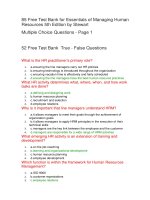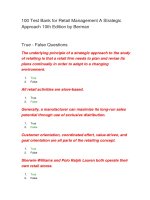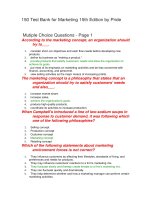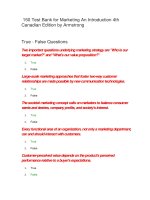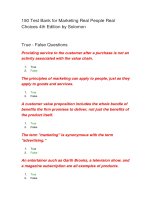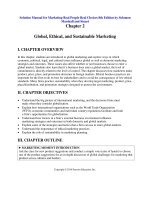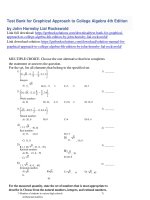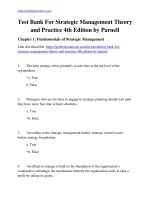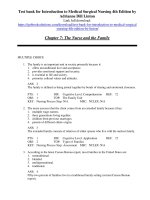150 test bank for marketing real people real choices 4th edition by solomon đề trắc nghiệm marketing
Bạn đang xem bản rút gọn của tài liệu. Xem và tải ngay bản đầy đủ của tài liệu tại đây (179.37 KB, 31 trang )
150 Test Bank for Marketing Real People Real
Choices 4th Edition by Solomon
True - False Questions
Providing service to the customer after a purchase is not an
activity associated with the value chain.
1.
2.
True
False
The principles of marketing can apply to people, just as they
apply to goods and services.
1.
2.
True
False
A customer value proposition includes the whole bundle of
benefits the firm promises to deliver, not just the
benefits of the product itself.
1.
2.
True
False
The term "marketing" is synonymous with the term
"advertising."
1.
2.
True
False
An entertainer such as Garth Brooks, a television show, and
a magazine subscription are all examples of products.
1.
2.
True
False
The elements of the marketing mix are the four Ps.
1.
2.
True
False
Ria, a college sophomore, writes a daily blog that typically
has over 50,000 readers each week. This is an example
of consumer generated content.
1.
2.
True
False
The first phase of marketing decision making process is the
development of a market position.
1.
2.
True
False
According to the theory of the wisdom of crowds, companies
that make some of their products available for free are
actually able to generate more revenue than
companies that charge for all of their products.
1.
2.
True
False
Differential benefits set products apart from competitors'
products by providing something unique that
customers want.
1.
2.
True
False
A marketer who wants to achieve a competitive advantage
over her rivals cannot use the marketing mix to
achieve this goal.
1.
2.
True
False
With the advent of the Internet, a CRM approach became
much easier to implement.
1.
2.
True
False
Within the context of the marketing mix, place refers to the
availability of the product to the customer at the
desired time and location.
1.
2.
True
False
Automobiles, haircuts, tutoring, and lighting fixtures are all
examples of consumer goods.
1.
2.
True
False
Marketers define a need as the difference between a
consumer's actual state and some ideal or desired
state.
1.
2.
True
False
The customer relationship management concept maintains
that marketers must satisfy customers' needs in ways
that also benefit society.
1.
2.
True
False
Although having something to eat or drink may be a want,
the desire for a specific brand name is referred to as a
need.
1.
2.
True
False
The pricing element of the marketing mix always involves
monetary exchanges.
1.
2.
True
False
The promotion element of the marketing mix includes the
design of the product.
1.
2.
True
False
The marketing acronym ROI stands for rely on instinct.
1.
2.
True
False
A firm has a distinctive competency when it is able to
outperform the competition, providing customers with
a desired benefit the competition does not.
1.
2.
True
False
Very little of the online action in e-commerce is in businessto-business marketing.
1.
2.
True
False
Many not-for-profit organizations practice the marketing
concept.
1.
2.
True
False
To calculate lifetime value, a company would estimate the
amount of money a person would spend with the
company over a lifetime and then subtract what it will
cost the company to maintain this relationship.
1.
2.
True
False
The marketing mix is the marketer's strategic toolbox.
1.
2.
True
False
Mutiple Choice Questions - Page 1
A ________ is a desire for a particular product a consumer
uses to satisfy a need in a specific way that is
culturally and socially influenced.
1.
2.
3.
4.
5.
a. benefit
b. demand
c. value
d. utility
e. want
To be part of the ________ for a product, consumers must
share a common need that can be satisfied by the
product and have the resources, willingness, and
authority to purchase the product.
1.
2.
3.
4.
5.
a. demand center
b. audience
c. value proposition
d. marketplace
e. market
________ refers to the benefits a customer receives from
purchasing a good or service.
1.
2.
3.
4.
5.
a. Satisfaction
b. Demand
c. Want
d. Promotion
e. Customer Value
A customer's desire for a product coupled with the buying
power or resources to obtain that product is called a
________.
1.
2.
3.
4.
5.
a. benefit
b. demand
c. need
d. stake
e. service
A perspective that consumer spending, and hence the
economy, is driven by psychological attachment to
brands, the relevance ofinformation, and solutions is
called
1.
a. customer relationship management
2.
3.
4.
5.
b. Attention Economy
c. market positioning
d. creating sustainability
e. increasing the lifetime value of customers
As described in the opening vignette of Chapter 1,
customers return to the Yellow Point Lodge each year
because it offers comfort and wonderful memories of
years past. This is an example of ________.
1.
2.
3.
4.
5.
a. marketing mix
b. Customer Value
c. Marketing Position
d. Marketing Integration
e. Desired Attributes
When a gap exists between a consumer's actual state and
some ideal or desired state, the consumer has a
________.
1.
2.
3.
4.
5.
a. benefit
b. demand
c. need
d. value
e. utility
A glitzy shopping mall, a mail-order catalog, a television
shopping network, and an e-commerce Web site are all
examples of ________.
1.
2.
3.
4.
5.
a. marketing concepts
b. value chains
c. monopolies
d. marketplaces
e. strategic business units
Marketers first identify consumer needs and then provide
products that satisfy those needs. This practice is
referred to as ________.
1.
2.
3.
4.
5.
a. the stakeholder orientation
b. the marketing concept
c. Total Quality Management
d. the production orientation
e. the marketing mix
In general, companies that focus on a triple bottom line are
most likely to place a priority on which of the
following?
1.
2.
3.
4.
5.
a. sustainability
b. the production orientation
c. the selling orientation
d. manufacturing on demand
e. instapreneurship
For an exchange to occur, ________.
1.
2.
3.
4.
5.
a. at least two people or organizations must be willing to make a trade, and each
must have something the other wants
b. there must be one winner and one loser
c. someone must make a financial profit
d. the item must be tangible
e. time utility must be created
Which of the following lists the three components of the
triple bottom line orientation?
1.
2.
3.
4.
5.
a. the financial bottom line, the social bottom line, and the environmental bottom
line
b. the financial bottom line, the social bottom line, and the political bottom line
c. the financial bottom line, the cultural bottom line, and the business bottom line
d. the value bottom line, the service bottom line, and the business bottom line
e. the product bottom line, the service bottom line, and the relationship bottom line
A ________ orientation is a management philosophy that
focuses on ways to satisfy customers' needs and
wants.
1.
2.
3.
4.
5.
a. consumer
b. promotion
c. selling
d. production
e. quality
Buyers, sellers, investors, and community residents are all
considered ________ in a company.
1.
2.
3.
4.
5.
a. stakeholders
b. shareholders
c. consumers
d. value chain members
e. social marketers
Which of the following is NOT a marketing field?
1.
2.
3.
4.
5.
a. supply-channel management
b. accounting
c. brand management
d. advertising
e. new product planning
A firm that focuses on a ________ orientation is likely to
learn an important lesson the hard way – consumers
do not buy products,they buy benefits.
1.
2.
3.
4.
5.
a. product
b. consumer
c. sustainability
d. CRM
e. TQM
Companies that have a ________ orientation tend to be more
successful at making one-time sales than at building
repeat business.
1.
2.
3.
4.
5.
a. consumer
b. marketing
c. selling
d. societal
e. relationship
A company that focuses on ________ is concerned with
meeting present consumer needs without
compromising the ability of future generations to meet
their needs.
1.
2.
3.
4.
5.
a. the selling orientation
b. the production orientation
c. Total Quality Management
d. Sustainable Development
e. return on investment
The Internet has created a paradigm shift for businesses,
moving us toward an attention economy in which a
company's success will be measured by its ________.
1.
2.
3.
4.
5.
a. sustainability
b. social responsibility
c. consumer-generated value
d. social network
e. share of mind
From a marketing perspective, when one student eats trail
mix for lunch while another eats a cheeseburger and
french fries, they are demonstrating differences in
________.
1.
2.
3.
4.
5.
a. Benefit
b. Wants
c. Demand
d. Need
e. Drive
A(n) ________ is the ultimate user of a good or service.
1.
2.
3.
4.
5.
a. stakeholder
b. market
c. target market
d. marketer
e. consumer
________ maintains that marketers must satisfy customers'
needs in ways that also benefit society and are
profitable to the firm.
1.
2.
3.
4.
5.
a. Value propositioning
b. Customer relationship management (CRM)
c. The social marketing concept
d. A sales orientation
e. Value chain management
________ involves systematically tracking consumers'
preferences and behaviors over time in order to tailor
the value proposition as closely as possible to each
individual's unique wants and needs.
1.
2.
3.
4.
5.
a. Value propositioning
b. Customer relationship management (CRM)
c. Differential benefit development
d. Sales orientation
e. Value chain management
________ is the activity, set of institutions, and processes for
creating, communicating, delivering, and exchanging
offerings that have value for customers, clients,
partners, and society at large.
1.
2.
3.
a. Demand satisfaction
b. Competitive advantage building
c. Marketing
4.
5.
d. Total Quality Management
e. Value chain management
Marketing of goods and services from one organization to
the other is called ________
1.
2.
3.
4.
5.
a. social marketer
b. business-to-business marketing
c. e-commerce marketer
d. marketing planner
e. instapreneur
A consumer paying for their purchases at a retail store with a
credit card illustrates which of the following marketing
concepts?
1.
2.
3.
4.
5.
a. Exchange of Value
b. Want
c. Demand
d. Need
e. Drive
A ________ is the outcome that motivates a customer's
buying behavior.
1.
2.
3.
4.
5.
a. benefit
b. demand
c. value
d. need
e. want
In which kind of market would a product orientation be most
successful?
1.
2.
3.
a. a buyer's market in which supply exceeds demand
b. a market in which there are more sellers than buyers
c. a seller's market in which the seller focusses on production and distribution of
the product
4. d. a market that sells only intangible products
5. e. no market
________ is about delivering value to everyone who is
affected by a transaction.
1.
2.
3.
4.
5.
a. Demand
b. Competitive advantage
c. Marketing
d. Exchange
e. The value chain
Carrie is shopping for a new watch. She is looking at a Timex
and at a Rolex. The fact that either watch will give her
the correct time is an example of a ________.
1.
2.
3.
4.
5.
a. Benefit
b. Want
c. Demand
d. Need
e. Drive
100 Free Test Bank for Marketing Real People Real
Choices 4th Canadian Edition by Solomon Mutiple
Choice Questions - Page 2
The main activities of value chain members include all of the
following EXCEPT ________.
1.
2.
3.
4.
5.
a. bringing in materials to make the product
b. converting the materials into the final product
c. providing unbiased information about the product to consumers
d. shipping out the final product
e. servicing the product after purchase
________ are the tangible products that individuals purchase
for personal or family use.
1.
2.
3.
4.
5.
a. Consumer services
b. Consumer goods
c. E-services
d. E-products
e. Industrial goods
________ are intangible products that we pay for and use but
never own.
1.
2.
3.
4.
5.
a. Consumer goods
b. Services
c. Industrial goods
d. E-commerce products
e. Value products
Apple relied on its inventive product designers to create a
________, a futuristic looking computer in a multitude
of colors.
1.
2.
3.
a. promotion
b. value chain
c. service
4.
5.
d. differential benefit
e. market segment
The ________ is a document that describes the marketing
environment, outlines the marketing objectives and
strategy, and identifies who will be responsible for
carrying out each part of the marketing strategy.
1.
2.
3.
4.
5.
a. marketing mix
b. marketing plan
c. value proposition
d. value chain
e. open source model
More goods and services are sold in the ________ market
than in the ________ market.
1.
2.
3.
4.
5.
a. domestic; international
b. business-to-business; consumer
c. consumer; producer
d. industrial; business-to-business
e. e-commerce; Internet
The relationship between marketing and ___________is a
two-way street. Marketers influence what is popular,
but products and the communication of those
products also reflect the key social beliefs and values
of the times.
1.
2.
3.
4.
5.
a. myths
b. social services
c. consumer goods
d. Popular culture
e. value propositions
It is most accurate to say that popular culture consists of the
________ that the mass market consumes.
1.
2.
3.
4.
5.
a. myths
b. social services
c. consumer goods
d. forms of entertainment
e. value propositions
A ________ consists of all possible customers in a market
regardless of the differences in their specific needs
and wants.
1.
a. popular culture
2.
3.
4.
5.
b. value chain
c. marketing mix
d. marketing concept
e. mass market
Which of these statements about mass marketing is true?
1.
2.
a. A mass marketing strategy is always preferable to a target marketing strategy.
b. The success of any organization's marketing efforts depends on its ability to
engage in mass marketing.
3. c. Mass marketing can be cost effective.
4. d. Mass marketing allows marketers to develop products to satisfy the specific
needs and wants of specific groups of customers.
5. e. Automakers typically use a mass marketing strategy.
________ is the buying and selling of products over the
Internet.
1.
2.
3.
4.
5.
a. Consumer-generated marketing
b. Consumer relationship management
c. E-commerce
d. Social marketing
e. Social networking
________ is the first step in the process of decision making
process in Marketing.
1.
2.
3.
4.
5.
a. The marketing mix
b. Total Quality Management
c. Understand the Opportunity
d. Customer relationship management
e. Value proposition creation
A ________ is a group of people that have different needs,
wants, or preferences from other groups of people and
would seek a different value. Proposition (solution).
1.
2.
3.
4.
5.
a. product position
b. market segment
c. mass market
d. value proposition
e. target market
Coca-Cola's unique and skillful marketing communications
represent the company's ________.
1.
2.
3.
4.
a. consumer-generated value
b. production orientation
c. distinctive competency
d. return on investments
5.
e. lifetime value
__________is a physiological or psychological dependency
on goods or services.
1.
2.
3.
4.
5.
a. Being a customer
b. social marketing techniques
c. consumer addiction
d. social networking
e. commodity
Which of the following is a major marketing decision for
most companies?
1.
2.
3.
4.
a. the type of metrics used to calculate ROI
b. how many people to employ
c. the geographic layout of the factory making the product
d. which products to market to which consumers without turning off other
consumers
5. e. the accounting method used to report earnings
________ marketing is the marketing of goods and services
from one organization to another.
1.
2.
3.
4.
5.
a. Distributive
b. Consumer
c. Customer
d. Business-to-business
e. Target
Alcoholism and cigarette smoking are both examples of
________.
1.
2.
3.
4.
5.
a. anticonsumption behaviors
b. bait-and-switch behaviors
c. consumer addictions
d. shrinkage
e. consumed consumer behaviors
________ is a decision process in which marketing
managers determine the strategies that will help the
firm meet its long-term objectives and then execute
those strategies using the tools they have at their
disposal.
1.
2.
3.
4.
5.
a. Total Quality Management
b. Sustainability
c. Return on investment
d. Marketing
e. The open source model
A social movement directed at protecting consumers from
harmful business practices is called____________.
1.
2.
3.
4.
5.
a. demarketing
b. exploitative consumption
c. addictive consumption
d. shrinkage
e. Consumerism
Which of the following refers to marketing strategies that
support environmental stewardship by establishing an
environmentally founded differential benefit in the
minds of consumers?
1.
2.
3.
4.
5.
a. greenwashing
b. green marketing
c. triple bottom line orientation
d. social marketing
e. social networking
The direct financial impact of a firm's expenditure on
marketing activities is called the ________.
1.
2.
3.
4.
5.
a. value chain
b. value proposition
c. differential benefit
d. return on investment (ROI)
e. utility function
________ provides reasons for customers to pay a premium
for a firm's products and exhibit a strong brand
preference.
1.
2.
3.
4.
5.
a. An exchange
b. A differential benefit
c. An industrial good
d. A promotion position
e. A customer lifetime value
A ________ is a series of activities involved in designing,
producing, marketing, delivering, and supporting any
product.
1.
2.
3.
4.
5.
a. value proposition
b. production orientation
c. value chain
d. marketing concept
e. market position
The second step in developing a competitive advantage is to
turn a distinctive competency into a ________ that is
important to customers.
1.
2.
3.
4.
5.
a. target market
b. service
c. marketing mix
d. market position
e. differential benefit
Social networking is an integral part of which of the
following?
1.
2.
3.
4.
5.
a. the triple bottom line orientation
b. lifetime value of a customer
c. the value chain
d. Web 2.0
e. Web 1.0
_________ is outsourcing tasks to an undefined, large group
of people or community by posting an open call for
assistance on the Internet.
1.
2.
3.
4.
5.
a. microcelebrities
b. Crowdsourcing
c. folksonomists
d. open sourcers
e. instapreneurs
In addition to marketing activities, the ________ includes
business functions such as human resource
management and technology development.
1.
2.
3.
4.
5.
a. value chain
b. marketing mix
c. utility function
d. customer relationship management process
e. market position
When companies calculate the lifetime value of a customer
they look at ________.
1.
a. how much profit they expect to make from a particular customer, including each
and every purchase she will make from them now and in the future
2. b. the positive word of mouth about the product that the customer can spread
among her family, friends, and acquaintances
3. c. the lifetime expectancy of the product the customer purchased
4. d. the age of the customer to see whether she is likely to live long enough to utilize
the product being sold
5.
e. the career path of the customer to see if she may move to a different
geographic area and no longer purchase from the company
Which of the following is true of Web 2.0?
1.
2.
3.
4.
5.
a. It categorizes entries according to a strict taxonomy.
b. It gets updated constantly.
c. It is based on the open source model.
d. It is based on the wisdom of crowds model.
e. It improves as the number of users decreases.
According to the theory of the wisdom of crowds, under the
right circumstances ________.
1.
2.
3.
4.
5.
a. a mass market approach is favorable to a target market approach
b. a target market approach is favorable to a mass market approach
c. groups are smarter than the smartest people in them
d. companies can make money by giving their products away for free
e. consumers can generate value
A firm's capability that is superior to that of its competition is
referred to as a(n) ________.
1.
2.
3.
4.
5.
a. distinctive competency
b. added value
c. value proposition
d. value chain
e. social benefit
The phenomenon of ________ includes consumers creating
their own ads and buying and selling products on
eBay.
1.
2.
3.
4.
5.
a. production orientation
b. the triple bottom line orientation
c. consumer-generated content
d. socially responsible marketing
e. the marketing concept
______________looks at how much profit they expect to
make from a particular customer, including each and
every purchase he or she will make from them now
and in the future.
1.
2.
3.
4.
5.
a. bait-and-switch
b. anticonsumption
c. demarketing
d. shrinkage
e. lifetime value of a customer
100 Free Test Bank for Marketing Real People Real
Choices 4th Canadian Edition by Solomon Mutiple
Choice Questions - Page 3
Which of the following is an example of a transaction that
might occur in business-to-business marketing?
1.
2.
3.
4.
5.
a. Maurice buys a new razor on his way home from work.
b. The amateur gardener buys a new wheelbarrow.
c. The retail outlet buys athletic shoes to sell in its store.
d. The professional chef bakes a birthday cake for her son.
e. Robyn's mother hires a math tutor to help Robyn pass algebra.
A flour producer that identifies its mission as "the milling of
finest flour” most likely has a ________ orientation.
1.
2.
3.
4.
5.
a. customer
b. marketing
c. selling
d. product
e. new era
Which of the following is the best example of a service?
1.
2.
3.
4.
5.
a. the medical examination Jonathon had yesterday
b. the sheet music purchased by the piano teacher
c. the software Monica purchased from the Web site
d. the cleaning supplies purchased for the veterinarian's office
e. the t-shirt you got for running in a 5K race
When comparing itself to its competitors, Hidden Valley
describes its Ranch dressing as the original. This is
the ________ the manufacturer has selected for the
product.
1.
2.
3.
4.
5.
a. marketing mix
b. market segment
c. Posistioning
d. marketing concept
e. value chain
The ________ consists of the tools an organization uses to
create a desired response among a set of predefined
consumers.
1.
2.
3.
a. distinctive competency
b. market position
c. value proposition
4.
5.
d. differential benefit
e. marketing mix
There are several different sports watches for cyclists. When
compared to its competitors, the Bike Nashbar watch
is the least expensive. The Acumen Basicis the only
one designed for older cyclists who prefer a larger
display. Each of these watches is providing
a____________________.
1.
2.
3.
4.
5.
a. marketing mixes
b. mass marketing strategies
c. Differential benefit
d. consumer orientations
e. selling orientations
A ________ is defined as a market segment on which an
organization focuses its marketing plan and toward
which it directs its marketing efforts.
1.
2.
3.
4.
5.
a. social network
b. market convergence
c. subculture
d. value chain
e. target market
Shane pulled her car into the gas station just as the fuel
gauge dropped below empty. In this example, Shane
benefited from the ________ offered by the gas
station.
1.
2.
3.
4.
5.
a. creation
b. Convenient location
c. value
d. marketing
e. quality
Kao Corp., which makes Ban deodorant, invited teenage girls
to make an ad that would encourage other girls to buy
the product. This program is an example of ________.
1.
2.
3.
4.
5.
a. the wisdom of crowds
b. the production concept
c. the selling orientation
d. open source modeling
e. consumer-generated content
Two teachers purchased art supplies for their classes. One
paid $103.45 for eight large boxes of crayons. The
other teacher purchased ten identical boxes for
$105.55. The second teacher got more for her money
because she took advantage of a quantity discount.
This relates to__________ element of marketing mix.
1.
2.
3.
4.
5.
a. production
b. profit
c. price
d. place
e. possession
Which of the following is a true statement about the Four Ps
of the marketing mix?
1.
2.
3.
4.
5.
a. A decision about one of the Ps affects every other marketing-mix decision.
b. Product is always the most important of the Four Ps.
c. Place is typically the least important of the Four Ps.
d. The Four Ps have little effect on a product's market position.
e. The Four Ps are used to determine a product's target market.
A ________ is a good, service, idea, place, or person-whatever is offered for sale in the exchange.
1.
2.
3.
4.
5.
a. product
b. place
c. utility
d. benefit
e. demand
A market positioning refers to ________.
1.
2.
3.
4.
5.
a. the organization's decision to use no more than two elements of the marketing
mix
b. the location where the organization sells its products
c. the specific means the organization uses to distribute its products
d. how the target market perceives a product in relation to competitors' products
e. the strategic planning and execution of the marketing mix
________ is the assignment of a product's value, or the
amount the consumer must exchange to receive the
offering.
1.
2.
3.
4.
a. Promotion
b. Price
c. Benefit
d. Need
5.
e. Utility
Jolene's firm markets preplanning services for a mortician.
She finds that most of her target market wants to avoid
discussing future funeral needs, so she must
somehow first get their attention. Jolene's firm most
likely uses the ________.
1.
2.
3.
4.
5.
a. production orientation
b. sustainability concept
c. selling orientation
d. consumer orientation
e. social marketing concept
Chris just landed her dream job but realizes that her college
wardrobe is not going to work for her new professional
position. In this situation, Chris has a(n) ________.
1.
2.
3.
4.
5.
a. benefit
b. exchange
c. value
d. need
e. utility
Seth's mother didn't want to have a climbing wall as a
permanent feature in her backyard, but it was certainly
convenient to rent one from the company that catered
Seth's twelfth birthday party. This is an example of
providing ________ to the customer.
1.
2.
3.
4.
5.
a. demand
b. place and creation
c. need
d. benefit
e. creation and possession
Alex paid for a(n) ________ when he took his car to the
carwash to be washed and waxed.
1.
2.
3.
4.
5.
a. service
b. industrial product
c. consumer good
d. commercial
e. business product
When Tony rented a loft apartment where he would live for
the summer, he acted as a(n) ________.
1.
2.
3.
4.
5.
a. consumer
b. shareholder
c. producer
d. marketer
e. retailer
An organic farmer has identified three distinct groups who
might be interested in his products: vegetarians,
people who are concerned about chemicals in their
foods, and people who consider themselves
innovators and trendsetters. These three groups are
1.
2.
3.
4.
5.
a. marketing mixes
b. market segments
c. product mixes
d. mass markets
e. market positions
IBM manager Celia Moore coordinates IBM's long-standing
"Reinventing Education" program that involves
intensive research into how educational institutions
can use the fruits of new technologies to transform
what they do. In the process, the program is a
1.
2.
3.
4.
5.
a. environmental
b. financial bottom line
c. selling
d. production
e. triple bottom line
Greg Williams now has the buying power to purchase the
computer system he has wanted for the last six
months. Greg's want now has become a(n) ________.
1.
2.
3.
4.
5.
a. need
b. necessity
c. demand
d. exchange
e. transaction
Which element of the marketing mix is most closely
associated with a company's supply chain?
1.
a. production
2.
3.
4.
5.
b. place
c. price
d. profit
e. promotion
A(n) ________ occurs when Rhonda Albers trades Max
Lynch three hours of babysitting his three-year-old
daughter for fixing the hole in her porch roof.
1.
2.
3.
4.
5.
a. differential benefit
b. promotion
c. exchange
d. reciprocal loss
e. virtual trade
Conveniently located vending machines around your college
or university campus make it easy for you to buy a
soda and a snack between classes. This is an example
of the ________ element of the marketing mix.
1.
2.
3.
4.
5.
a. production
b. place
c. price
d. profit
e. promotion
A new shampoo advertisement on television tells all of the
wonderful benefits the consumer will enjoy when
using one company's shampoo as opposed to another
shampoo. What is this company seeking to convey in
this television commercial?
1.
2.
3.
4.
5.
a. the product's time utility
b. the product's distinctive competency
c. the company's production orientation
d. the company's marketing segmentation process
e. the product's differential benefits
The Four Ps are ________.
1.
2.
3.
4.
5.
a. price, product, place, and promotion
b. price, profit, production, and possession
c. product, production, possession, and promotion
d. product, promotion, price, and profit
e. place, production, process, and profit
Jack provides heating and air conditioning equipment for
office buildings. He sells ________.
1.
2.
3.
4.
5.
a. distributive goods
b. consumer services
c. consumer goods
d. industrial goods
e. intangible goods
A sign manufacturer who uses plastic, metal, and neon
tubing to create a motel sign has provided___________
of choice that people look forutility.
1.
2.
3.
4.
5.
a. benefit
b. place
c. possession
d. time
e. creation
Which of the following is an example of a not-for-profit
organization that would use marketing principles?
1.
2.
3.
4.
5.
a. a fast-food restaurant
b. a manufacturer of bicycles
c. a software developer
d. an amusement park
e. the Red Cross
A ________ is a distinctive group of customers within a
larger market who are similar to one another in some
way and whose needs differ from other customers in
the larger market.
1.
2.
3.
4.
5.
a. market segment
b. popular culture
c. mass market
d. market mix
e. market position
A catalog retailer has identified African-American
professionals between the ages of thirty-five and fortyfive as the group of customers within the larger market
that is a potential market for its products. This is an
example of___________.
1.
2.
3.
a. targeting
b. marketing mix
c. product mix
4.
5.
d. mass market
e. market aggregation
The ________ element of the marketing mix communicates
the value proposition using forms such as personal
selling, advertising, coupons, and publicity.
1.
2.
3.
4.
5.
a. production
b. place
c. price
d. distribution
e. Communication (promotion)
Ruth Terry is a realtor. In her ads, Terry offers the free use of
a moving truck to every customer she helps either buy
or sell a house. This free use of a moving truck is an
example of a(n) ________.
1.
2.
3.
4.
5.
a. benefit
b. demand
c. social marketing concept
d. need
e. production orientation
Which of the following is the best example of a consumer
good?
1.
2.
3.
4.
5.
a. the riding lawn mower purchased by the landscaping company
b. the disposable diapers purchased by the new mother for her baby
c. the paint purchased by the contractor
d. the cookies purchased for the daycare center
e. the art supplies purchased for the elementary school art center
Which of the following is part of the product element of the
marketing mix?
1.
2.
3.
4.
5.
a. a quality discount
b. a store coupon
c. a newspaper advertisement
d. the packaging
e. publicity releases
